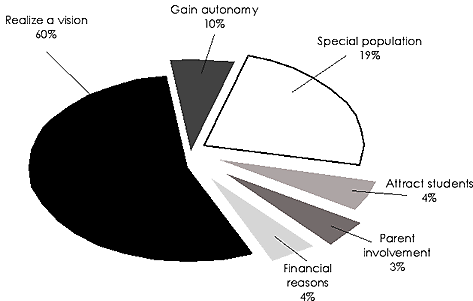
Archived Information
The State of Charter Schools Third-Year Report — May 1999Why Charter Schools Are Started
Implementation Challenges
Autonomy And Control
Autonomy And Choice Of Service Providers
External Accountability And Monitoring
External Accountability And Reporting
Accountability And Student Assessment
|
Why are charter schools founded? Each founding story is unique, but broad patterns are discernible across different types of charter schools Charter schools begin from the inspiration of educators, parents, or community leaders who want to create a different learning environment for children. As the founders see it, most seek an alternative vision of schooling that they could not realize in the general public school system. Newly created schools in particular report on curriculum and instructional approaches they want to establish and the organizational climate they wish to create. Many pre-existing public schools converted to charter status in order to gain increased autonomy, while many pre-existing private schools sought to attain stable funding and attract students to their approach. Finally, some charter schools— about one in four—established their charter to serve a special population of students, often ones that were "at-risk" in the general public school system. |
| Total | Total | Newly created | Pre-existing public | Pre-existing private | |
| 615 | 595 | 422 | 115 | 58 | |
| Realize an alternative vision | 73.0% | 58.9% | 67.5% | 40.0% | 34.5% |
| Gain autonomy/flexibility | 16.3% | 10.3% | 3.6% | 38.3% | 3.4% |
| Serve special population | 26.2% | 19.5% | 22.7% | 7.8% | 19.0% |
| Attract students | 10.2% | 3.9% | 1.9% | 1.7% | 22.4% |
| Financial reasons | 8.6% | 3.9% | 0.9% | 7.0% | 19.0% |
| Parent involvement | 10.2% | 3.6% | 3.3% | 5.2% | 1.7% |
NOTE: These data rely on responses from 615 out of 619 open charter schools that responded to the survey. Schools were asked about their reasons for founding the first time they were surveyed. In one survey question, schools were asked the reason for founding their schools and they could reply with more than one reason (reported in column 2 above). In a separate question, schools were asked to choose one of the named reasons as the primary reason for founding their school (reported in columns 3 through 6 above); the data from 595 of the 615 charter schools are included for columns 3 through 6 because 20 schools did not choose a primary reason. The data presented in columns 4 through 6 represent the percentage of the total number of each type of school. The valid number of pre-existing public schools is 115 out of 120 possible open schools; the valid number of pre-existing private schools is 58 out of 65 possible open schools; the valid number of newly created charter schools is 422 out of 434 possible open schools. The difference between the valid and possible number of schools is because some schools did not select a primary reason for founding their charter school.

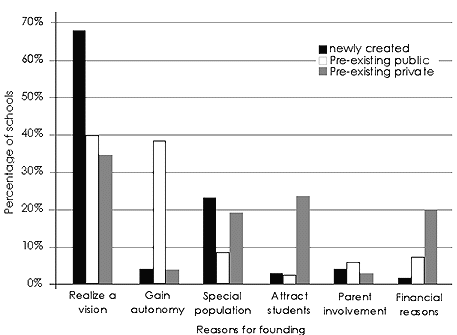
|
Our research suggests that many charter founders face significant challenges in starting and operating a charter school. We asked a knowledgeable respondent at each charter school in every year of the Study to rate the difficulty of overcoming each barrier in a list of possible barriers to charter school implementation. The most pressing challenges for newly created charter schools concern financial difficulties and other problems akin to starting a new business. Many pre-existing public schools that converted to charter status also have experienced political and bureaucratic difficulties during development and implementation. |
| Total | Newly created | Pre-existing public | Pre-existing private | |
| Lack of start up funds | 54.7% | 60.4% | 34.6% | 52.7 |
| Lack of planning time | 37.4% | 39.7% | 34.8% | 26.7% |
| Inadequate facilities | 35.8% | 39.1% | 25.2% | 31.5% |
| Inadequate operating funds | 41.4% | 44.6% | 34.2% | 32.7% |
| State or local board opposition | 20.7% | 19.2% | 29.1% | 15.1% |
| District resistance or regulations | 19.9% | 20.6% | 22.8% | 10.2% |
| Internal processes or conflicts | 14.2% | 15.5% | 11.7% | 10.0% |
| State dept. of education resistance | 13.5% | 11.8% | 17.7% | 18.3% |
| Health and safety regulations | 11.3% | 12.6% | 2.7% | 18.3% |
| Union or bargaining unit opposition | 9.8% | 9.1% | 13.3% | 8.6% |
| Accountability requirements | 8.9% | 8.5% | 9.0% | 11.6% |
| Hiring staff | 8.8% | 8.9% | 10.7% | 5.0% |
| Collective bargaining agreements | 7.0% | 4.8% | 18.0% | 1.7% |
| Community opposition | 6.0% | 7.8% | 2.7% | 0.0% |
| Federal regulations | 5.6% | 5.4% | 4.4% | 10.0% |
| Teacher certification requirements | 4.9% | 4.5% | 7.2% | 3.4% |
NOTE: These data are drawn from questions asked only in the new school surveys. Responses to these questions about barriers represent a range of 204 to 210 out of 230 open charter schools that responded to the 1996 new schools survey; 120 to 149 out of 153 open charter schools that responded to the 1997 new schools survey; and 238 to 244 out of 246 open charter schools that responded to the 1998 new schools survey. Overall, the responses represent a range of 571 to 601 out of 619 open charter schools that responded to one of the three new school surveys.
1 We asked schools to rate the difficulty of each barrier on a scale from 1 to 5, with 1 being not at all difficult and 5 being very difficult. The percentages in this table represent the percentages of schools that rated each barrier difficult or very difficult.
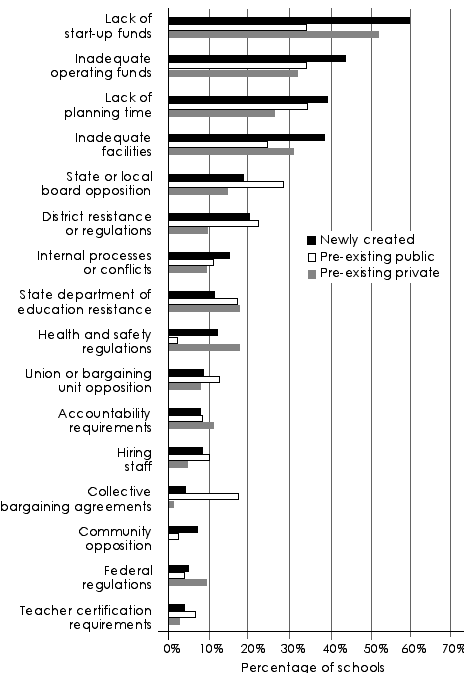
|
The increased autonomy inherent in the charter concept allows charter schools the flexibility to make independent decisions about both educational and management issues. In some cases, schools decisions are constrained either by provisions of the state's charter legislation or by decisions and practices implemented by their charter granting agency. One measure of a school's autonomy is the extent to which it can exercise control over critical decisions affecting its performance. Using school reports on their sense of control over critical decisions, we find that most charter schools feel they have considerable autonomy, except over student admissions policy. However, charter schools that converted from public school status appear to have less autonomy than newly created charter schools. |
| Area of control | ||||
| Budget | 76.3% | 18.9% | 2.4% | 2.4% |
| Purchase of supplies/equipment | 91.1% | 7.0% | 0.8% | 1.1% |
| School calendar | 78.9% | 18.8% | 1.0% | 1.3% |
| Daily schedule | 95.3% | 2.4% | 1.0% | 1.3% |
| Student assessment policies | 76.6% | 16.7% | 3.6% | 3.1% |
| Student admissions policies | 63.7% | 26.9% | 6.5% | 2.9% |
| Student discipline | 92.1% | 3.9% | 1.5% | 2.5% |
| Establishment of curriculum | 86.1% | 8.8% | 2.1% | 3.0% |
| Hiring of teaching staff | 89.3% | 6.3% | 1.6% | 2.8% |
NOTE: These data rely on responses from between 614 and 618 out of 619 open charter schools that responded to the telephone survey. Schools were asked to rate each of these items separately, resulting in the range of responses. One school did not respond to this survey item and five schools answered "don't know" for certain items. The data presented in columns 3 through 5 of the table on the facing page represent the percentage of each type of school responding to each item. The valid number of pre-existing public schools ranges from 118 to 120 schools; the valid number of open pre-existing private schools ranges from 63 to 65 open schools; the valid number of open newly created schools ranges between 431 to 434 schools. The difference in range is because some schools responded "don't know".
| Hiring of teaching staff | 89.3% | 90.8% | 84.0% | 89.2% |
| Establishment of curriculum | 86.1% | 88.2% | 77.1% | 87.7% |
| Student discipline | 92.1% | 93.1% | 90.0% | 89.2% |
| Student admissions policies | 63.7% | 66.7% | 58.8% | 51.6% |
| Student assessment policies | 76.6% | 78.9% | 72.5% | 68.3% |
| Daily schedule | 95.3% | 96.3% | 72.5% | 93.8% |
| School calendar | 78.9% | 83.6% | 58.3% | 85.9% |
| Purchase of supplies/equipment | 91.1% | 92.4% | 85.0% | 93.8% |
| Budget | 76.3% | 80.5% | 60.2% | 76.0% |
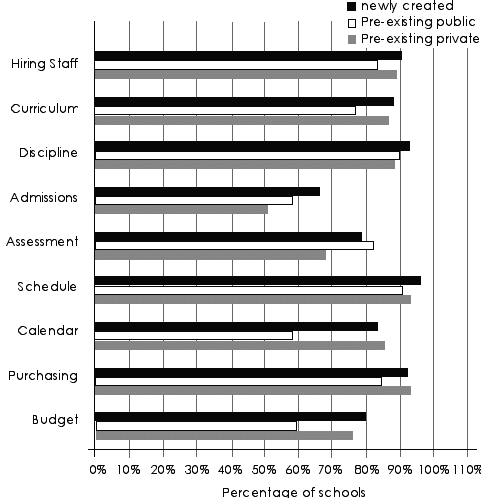
|
The autonomy afforded by the charter allows charter schools to make alternative arrangements for the acquisition of both goods and services. Autonomy also affords charter schools the opportunity to choose the mix of services offered to their students and families. Some charter schools have taken advantage of the flexibility provided by the charter to rethink how services are provided, including providing some services with either school staff or volunteers, purchasing the services from the district, or purchasing the services from an outside provider. Newly created, pre-existing public, and pre-existing private schools differ in the sources from which they acquire services. |
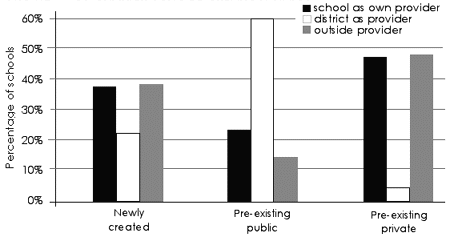
NOTE: These data rely on responses from 618 out of 619 open charter schools that responded to the telephone survey. These data are drawn from questions asked only in the first year of administration of the new school survey. This exhibit represents non-weighted averages across all service areas. Unweighted averages are used so as to not inflate the average for services that are more commonly provided.
| Services provided in charter schools (percentage of schools with services) | Percentage of schools with services provided solely by | |||
| Charter creation status | School as provider | District as provider | Outside provider | |
| Average of all services1 | 34.3% | 27.0% | 33.3% | Newly created | 36.2% | 21.1% | 36.9% | Pre-existing public | 22.2% | 58.9% | 13.6% | Pre-existing private | 46.0% | 3.5% | 47.1% |
| Payroll (100.0%) |
Total % across all types | 22.5% | 32.7% | 41.1% | Newly created | 24.5% | 26.1% | 45.5% |
| Pre-existing public | 7.5% | 73.3% | 17.5% | |
| Pre-existing private | 36.9% | 1.5% | 55.4% | |
| Accounting
(100.0%) |
Total % across all types | 33.2% | 23.9% | 33.5% | Newly created | 35.8% | 17.8% | 37.4% |
| Pre-existing public | 22.5% | 58.3% | 9.2% | |
| Pre-existing private | 35.4% | 1.5% | 52.3% | Insurance
(99.8%) |
Total % across all types | 19.3% | 30.5% | 47.8% |
| Newly created | 19.6% | 23.8% | 53.5% | |
| Pre-existing public | 12.5% | 70.0% | 15.8% | |
| Pre-existing private | 29.2% | 1.5 | 69.2% | Purchasing
(99.8%) |
Total % across all types | 57.2% | 23.0% | 13.3% |
| Newly created | 61.9% | 17.3% | 15.0% | |
| Pre-existing public | 28.3% | 55.0% | 5.8% | |
| Pre-existing private | 79.6% | 1.6% | 15.6% | |
| Custodial
(97.7%) |
Total % across all types | 45.5% | 20.4% | 31.1% |
| Newly created | 47.0% | 14.0% | 35.4% | |
| Pre-existing public | 33.6% | 53.8% | 11.8% | |
| Pre-existing private | 57.8% | 0.0% | 39.1% | |
| Building maintenance
(95.4%) |
Total % across all types | 37.0% | 19.4% | 36.2% |
| Newly created | 37.5% | 14.9% | 39.6% | |
| Pre-existing public | 28.6% | 57.1% | 8.2% | |
| Pre-existing private | 43.6% | 5.1% | 46.2% | |
| Legal services
(93.4%) |
Total % across all types | 18.4% | 27.7% | 50.0% |
| Newly created | 18.9% | 22.1% | 54.6% | |
| Pre-existing public | 10.4% | 61.7% | 23.5% | |
| Pre-existing private | 30.5% | 0.0% | 69.5% | |
| Health services
(80.9%) |
Total % across all types | 35.2% | 29.8% | 32.6% |
| Newly created | 38.9% | 23.5% | 34.9% | |
| Pre-existing public | 20.6% | 60.7% | 16.8% | |
| Pre-existing private | 40.8% | 6.1% | 51.0% | |
| Social services (79.6%) |
Total % across all types | 26.8% | 24.4% | 40.7% | Newly created | 25.4% | 20.0% | 46.0% | Pre-existing public | 23.8% | 47.6% | 20.0% |
| Pre-existing private | 40.4% | 5.8% | 48.1% | |
| Before/after school
Care (70.1%) |
Total % across all types | 64.2% | 10.4% | 18.5% |
| Newly created | 69.1% | 4.2% | 19.4% | |
| Pre-existing public | 48.4% | 33.7% | 8.4% | |
| Pre-existing private | 66.0% | 2.0% | 32.0% | |
| Food programs (66.8%) |
Total % across all types | 24.5% | 40.0% | 29.8% |
| Newly created | 22.9% | 35.4% | 35.4% | |
| Pre-existing public | 15.7% | 64.7% | 13.7% | |
| Pre-existing private | 57.5% | 7.5% | 32.5% | |
| Transportation
(65.2%) |
Total % across all types | 28.0% | 41.2% | 25.3% |
| Newly created | 32.4% | 34.4% | 25.9% | |
| Pre-existing public | 14.6% | 70.9% | 12.6% | |
| Pre-existing private | 34.1% | 9.8% | 53.7% | |
1The numbers in each of the "Total" rows do not add to 100% across the columns because respondents were also offered "Both" as a response.
|
Regardless of state law, charter schools enter into contracts with sponsoring entities in which freedom from regulations (except those related to health, safety and non-discrimination) is traded for increased accountability for outcomes. However, such external accountability is effective only if charter-granting or other agencies monitor charter schools in those areas for which they are to be held accountable. State legislation as well as regulatory practices vary greatly across states in the extent to which they do monitoring—and, indeed, in the extent to which they take a regulatory approach to holding charter schools accountable. |

| # of Schools in Sample | Instructional Practices | Student Achievement | Student Behavior | Student Attendance | |
| Total | 284 | 58.5% | 73.1% | 30.3% | 69.7% |
| State Arizona |
64 | 70.3% | 65.6% | 26.6% | 81.3% |
| California | 71 | 47.9% | 74.6% | 33.8% | 76.1% |
| Colorado | 30 | 46.7% | 90.0% | 33.3% | 66.7% |
| Georgia | 8 | 50.0% | 87.5% | 37.5% | 75.0% |
| Massachusetts | 15 | 93.3% | 93.3% | 26.7% | 53.3% |
| Michigan | 53 | 66.0% | 64.2% | 26.4% | 56.6% |
| Minnesota | 15 | 46.7% | 60.0% | 6.7% | 53.3% |
| New Mexico | 4 | 50.0% | 75.0% | 25.0% | 75.0% |
| Texas | 14 | 42.9% | 71.4% | 50.0% | 78.6% |
| Wisconsin | 10 | 50.0% | 70.0% | 20.0% | 40.0% |
| # of Schools in Sample | School Completion | School Governance | School Finances | Compliance with Regulations | |
| Total | 284 | 23.8% | 33.7% | 87.4% | 62.9% | State Arizona |
64 | 29.7% | 31.3% | 84.4% | 70.3% |
| California | 71 | 25.4% | 28.2% | 91.5% | 54.9% |
| Colorado | 30 | 30.0% | 23.3% | 83.3% | 63.3% |
| Georgia | 8 | 12.5% | 37.5% | 75.0% | 37.5% |
| Massachusetts | 15 | 6.7% | 80.0% | 100.0% | 46.7% |
| Michigan | 53 | 13.2% | 41.5% | 86.8% | 75.5% |
| Minnesota | 15 | 13.3% | 13.3% | 93.3% | 66.7% |
| New Mexico | 4 | 50.0% | 75.0% | 75.0% | 25.0% |
| Texas | 14 | 28.6% | 21.4% | 92.9% | 57.1% |
| Wisconsin | 10 | 30.0% | 30.0% | 60.0% | 50.0% |
NOTE: The percentages in the table show the number of schools that reported monitoring during the year in each area divided by the total number of schools in each state. This figure reports data from 294 charter schools referred to as a selected sample in the text. This question only appeared on the 1998 follow-up survey and so only schools that responded to the 1998 follow-up survey answered this question. This omits charter schools in their first year of operation. Schools in 16 states responded to the original survey and were approached with the follow-up survey. The data for ten schools are not presented by state because the schools are in five states (Alaska, Delaware, the District of Columbia, Florida, and Louisiana) that have three or fewer schools. The "Total" row does include data from these ten schools.
|
In exchange for freedom from laws and regulations that apply to other public schools, charter schools have increased accountability and reporting requirements. Reporting requirements and audiences for reporting differ by state and by individual charter school. Charter schools made reports to various constituencies on the school's progress towards its goals. All of a selected sample of charter schools have made or plan to make a report to at least one interested constituency. |
| Made a report | Planning to make a report | Not made or planning to make a report | Don't know | Not applicable | |
| Chartering agency | 55.4% | 34.4% | 8.5% | 0.7% | 1.0% |
| Private funders | 15.3% | 10.2% | 35.4% | 38.4% | 0.7% |
| Parents | 56.5% | 31.3% | 10.5% | 1.7% | 0.0% |
| Community/ general public | 36.1% | 17.0% | 41.5% | 4.8% | 0.7% |
| School governing board | 65.0% | 26.5% | 6.8% | 1.0% | 0.7% |
| State dept. of education, not chartering agency | 43.9% | 16.7% | 32.7% | 5.4% | 1.4% |
NOTE: These data are based on responses from all 294 charter schools that responded to the 1998 follow-up survey referred to as a selected sample in the text. This question only appeared on the 1998 follow-up survey and so only schools that responded to the 1998 follow-up survey answered this question.

| Chartering Agency | Private Funders | Parents | Community/ General Public |
School governing board | State DOE | Number of Schools | |
| Total | 89.8% | 25.5% | 87.8% | 53.1% | 91.5% | 60.6% | 294 |
| Arizona | 92.2% | 23.5% | 90.6% | 50.1% | 90.7% | 59.4% | 64 |
| California | 85.9% | 14.1% | 84.5% | 43.7% | 92.9% | 24.0% | 71 |
| Colorado | 100.0% | 40.0% | 83.4% | 60.0% | 93.3% | 66.7% | 30 |
| Georgia | 87.5% | 12.5% | 100.0% | 75.0% | 87.5% | 87.5% | 8 |
| Massachusetts | 93.3% | 60.0% | 93.4% | 80.0% | 100.0% | 93.3% | 15 |
| Michigan | 88.7% | 16.9% | 92.4% | 58.5% | 92.5% | 79.3% | 53 |
| Minnesota | 100.0% | 26.7% | 80.0% | 53.4% | 86.7% | 93.4% | 15 |
| New Mexico | 100.0% | 25.0% | 100.0% | 75% | 75.0% | 75.0% | 4 |
| Texas | 78.5% | 57.2% | 78.6% | 50.0% | 100.0% | 71.4% | 14 |
| Wisconsin | 70.0% | 30.0% | 90.0% | 50.0% | 70.0% | 50.0% | 10 |
1 The percentages in the table show the number of schools that reported or plan to report progress in each area divided by the total number of schools in each state. The data for ten schools are not presented by state because the schools are in five states (Alaska, Delaware, the District of Columbia, Florida, and Louisiana) that have three or fewer schools. The "Total" row does include data from these ten schools.
|
Charter schools are held accountable for the achievement of their students. Some charter legislation speaks specifically to improving student achievement as a goal for charter schools. Charter schools report using a number of measures of student achievement, some of them are traditional standardized assessment methods and others more innovative methods like portfolios and student demonstrations. |
| Type of assessment | Percentage of schools | |||
| Newly created | Pre-existing public | Pre-existing private | ||
| Standardized assessments | 86.4% | 87.6% | 84.2% | 83.1% |
| State assessment program | 74.8% | 77.1% | 70.0% | 69.2% |
| Performance assessments | 69.6% | 70.3% | 70.8% | 63.1% |
| Student portfolios | 78.8% | 81.5% | 78.3% | 63.1% |
| Student demonstrations of their work | 85.0% | 85.7% | 81.7% | 87.7% |
| Parent satisfaction surveys | 80.6% | 82.2% | 79.1% | 73.8% |
| Student interviews or surveys | 70.4% | 69.1% | 79.2% | 64.6% |
| Behavioral indicators | 75.1% | 73.7% | 85.0% | 67.7% |
NOTE: This exhibit draws on either 589 or 618 out of a possible 619 open charter schools that responded to the telephone survey. Three of the methods of assessments (standardized assessments, locally developed
performance assessments, national or state performance assessments) were items only asked about on the new schools surveys. For these three items, the total number of valid charter schools is 589, with results reflecting
responses from the year of administration of the new school survey. The remaining items have been asked consistently on both the new and follow-up surveys and the results reflect the most recent school responses.
Percentage Of Schools That Use Various Methods Of Assessment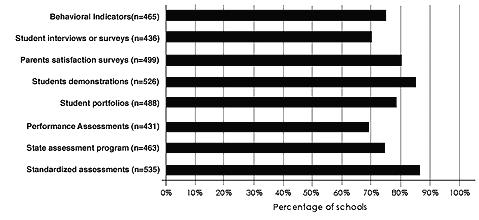
Across-State Comparison Of Estimated Percentage Of Schools Using Various Types Of Assessments
States (with 5 or more schools)
Standardized assessments
State assessment program
Performance assessments
Student portfolios
Student demonstrations of their work
Parent satisfaction surveys
Student interviews or surveys
Behavioral indicators
Total percentage
86.4%
74.8%
69.6%
79.0%
85.1%
80.6%
70.6%
75.2%
Alaska (12)
100.0%
66.7%
58.3%
66.7%
75.0%
83.3%
75.0%
50.0%
Arizona (127)
92.1%
70.9%
71.7%
81.1%
86.6%
68.5%
66.1%
69.3%
California (119)
86.7%
60.5%
74.2%
88.2%
82.4%
84.9%
75.6%
69.7%
Colorado (49)
87.8%
87.8%
79.6%
67.3%
75.5%
87.8%
55.1%
83.7%
Connecticut (11)
100.0%
100.0%
63.6%
90.9%
81.8%
81.8%
100.0%
81.8%
Florida (31)
93.5%
77.4%
74.2%
90.3%
83.9%
77.4%
74.2%
77.4%
Georgia (18)
100.0%
66.7%
61.1%
72.2%
94.4%
77.8%
66.7%
77.8%
Illinois (6)
100.0%
83.3%
83.3%
50.0%
100.0%
33.3%
33.3%
66.7%
Louisiana (6)
100.0%
50.0%
66.7%
66.7%
83.3%
66.7%
33.3%
50.0%
Massachusetts (21)
85.7%
90.5%
76.2%
95.2%
76.2%
95.2%
76.2%
85.7%
Michigan (95)
77.9%
75.8%
61.1%
68.4%
91.6%
88.4%
73.7%
74.7%
Minnesota (25)
80.0%
84.0%
60.0%
84.0%
80.0%
96.0%
92.0%
88.0%
North Carolina (27)
88.9%
88.9
63.0%
81.5%
88.9%
81.5%
63.0%
77.8%
New Jersey (6)
100.0%
66.7%
50.0%
100.0%
100.0%
50.0%
33.3%
83.3%
Texas (29)
72.4%
93.1%
65.5%
69.0%
86.2%
79.3%
69.0%
89.7%
Wisconsin (17)
52.9%
88.2%
88.2%
70.6%
94.1%
76.5%
70.6%
82.4%
-###-